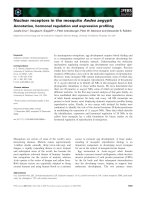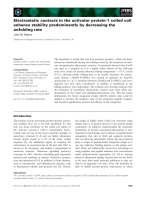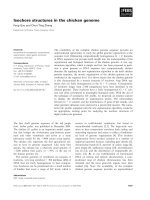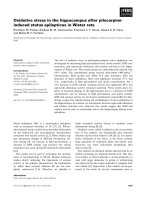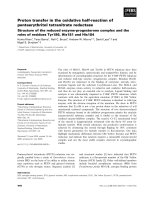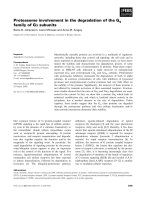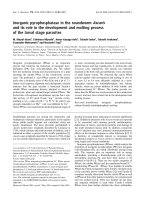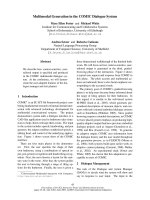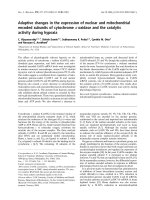Báo cáo khoa học: "Some Problems in the Mechanical Translation of German" pdf
Bạn đang xem bản rút gọn của tài liệu. Xem và tải ngay bản đầy đủ của tài liệu tại đây (157.25 KB, 7 trang )
[
Mechanical Translation
, vol.5, no.2, November 1958; pp. 60-66]
Some Problems in the Mechanical Translation of German
Leonard Brandwood, Birkbeck College, London, England*
I. RELATIVE CLAUSES
The problems discussed are those of syntactical ambiguity and multimeaning in
translating relative pronouns from German to English. The former, which is of
concern for the English word order, arises from the coexistence in German of
homomorphous inflections and variable word order, the latter from this combined
with gender dissimilarities in the two languages. Some statistics are given of the
frequency with which such ambiguities were encountered in scientific texts, and some
possible solutions or partial solutions discussed.
OUR CONCERN will be primarily with the prob-
lems of word order and multimeaning, and with
these not in all their aspects — which would be
too vast a subject for a short article — but
only in connection with one particular part of
sentence structure, the relative clause.
Besides relative adverbs, such as worin.
darin, etc., which cause no difficulty, German
uses three words to introduce relative clauses
— der, welcher and was. Certain grammatical
forms of these are common to two cases, with
the result that the syntactical function of such
forms is ambiguous, the types of ambiguity be-
ing three in number.
1. The masculine singular nominative of der
and welcher is identical to the feminine singu-
lar dative.
2. The masculine singular accusative of wel-
cher is identical to the dative plural.
3. The nominative form is identical to the ac-
cusative in the feminine singular of der and
welcher, in the neuter singular of der, welcher
and was, and in the plural (all genders) of der
and welcher.
The first two types are rare in comparison with
the third, the first especially so, because it can
arise only when the relative pronoun is not pre-
ceded by a preposition. If it is preceded by a
preposition, it is thereby denoted as the femi-
nine dative, since no preposition is constructed
with the nominative case. On the other hand,
* Now at the University of Manchester, Man-
chester, England.
without a preposition the feminine dative form
is very seldom encountered. For instance, in
samples of text amounting to about 30, 000 words
it never occurred once, while the masculine
nominative occurred over 50 times. In the sec-
ond type of ambiguity the dative form is like-
wise rare without a preposition, preference be-
ing given to the formally distinct denen. The
presence of a preposition, on the other hand,
does not solve the problem as before, unless
the preposition is of the type which can be con-
structed either with accusative or with dative,
but not with both.
However, we need not continue to discuss the
solution of these first two types, since it will
be contained in that of the main problem, the
distinction of nominative from accusative in the
feminine and neuter singular and the plural of
all genders.
In English the functions of subject and direct
object in a relative clause are indicated by the
fact that, when the relative pronoun is the sub-
ject, the direct object is separated from it by
the verb, e.g.,
Animals which eat men.
When the relative pronoun is the direct ob-
ject, the subject occurs on the same side of the
verb, e.g.,
Animals which men eat.
In German this distinction cannot be made by
the position of the verb because of the rule that
in a subordinate clause the verb must normally
come at the end. How, then, are we to deter-
mine the function of the relative pronoun in those
instances where the form of the relative provides
no help?
Mechanical Translation of German 61
1. The first step is to look at what follows im-
mediately after the relative pronoun, leaving
particles and the like out of consideration. If
what follows is not a substantive, or if it is, but
its form excludes the possibility of it being
nominative, then the relative pronoun may be
taken to be the subject of the clause. This ap-
plies to about half of all the instances where the
function of the relative pronoun is ambiguous.
2. On the other hand, if the form of the sub-
stantive following the relative pronoun can only
be nominative, the relative pronoun must be
the direct object. This accounts on average
for another 10 per cent of the total number of
instances.
3. Thirdly, the substantive following the rela-
tive might be either nominative or accusative
according to its form, but is indicated as one
or the other by its congruence or otherwise with
the verb (for this of course the relative pronoun
must be identifiably the opposite number in each
case). This too applies to about 10 per cent of
all instances.
The remaining 30 per cent are those where
the functionally ambiguous relative pronoun is
followed by an equally ambiguous substantive.
It is these which pose the real problem. Con-
sider, for example, the following two sentences
1. Wir werden die Eigenschaften solcher
Felder zu untersuchen haben sowie die
Bahnen, welche die Elektronen in diesen
Feldern beschreiben.
(We shall have to investigate the properties
of such fields, as well as the paths which the
electrons describe in these fields.)
2. Aus diesem Grunde müssen die Gleichun-
gen in einer Form vorliegen, welche die
unmittelbare Verwendung dieser verallge-
meinerten Koordinaten erlaubt.
(For this reason the equations must be in a
form which permits the direct use of these gen-
eralized co-ordinates.)
Now it should be remarked that, in the 70 per
cent cases so far solved, the relative pronoun
turns out to be the subject in 56 per cent of the
instances, the direct object only in 14 per cent.
We would therefore expect the ratio to be re-
versed in the remaining 30 per cent so far un-
solved; and the expectation is fulfilled, the
relative pronoun being the subject in only 5 per
cent, the direct object in 25 per cent. In short,
if the machine interprets every functionally am-
biguous relative pronoun which it has failed to
solve as the direct object of its clause, and
adopts the appropriate word order, it will be
wrong once in every six such instances. Judg-
ing from the frequency of relative pronouns in
texts investigated, this would mean about three
times in every 10, 000 words. An idea of what
the incorrect word order would sound like can
be obtained from the verbatim translation of
example 2 above.
If a more positive solution is required, it will
be necessary to consider not only the relative
pronoun, but also the substantive to which it re-
fers . Identification of this substantive alone will
sometimes produce a solution by enabling a re-
lative pronoun ambiguous in respect of number
as well as case to have its number determined.
Provided this differs from that of the succeed-
ing substantive, congruence with the verb will
indicate which is the subject, e.g.,
3. Wir werden die Gleichungen in der Form
anschreiben, welche sie bei Verwendung
dieser Einheiten annehmen.
(We shall write the equations in the form
which they assume when these units are used.)
If, on the other hand, the number of the rela-
tive pronoun proves to be identical with that of
the following substantive, other means of ar-
riving at a solution will be required. A diction-
ary for the machine must be compiled which
classifies words and indicates not only which
ones can be constructed together but also in
what way. Thus in the sentence
4. Allerdings wird die Wirkung dieser Felder
auf Elektronen, welche sie zu verschiedenen
Zeiten durchlaufen, verschieden sein.
(To be sure, the effect of these fields on
electrons which traverse them at different times
will be different.)
"electrons" can "traverse" "fields, * but not
vice versa: nor, since Wirkung may be the
other word referred to by welche or sie, are
"electrons" likely to "traverse" an "action."
The possibility, an "action" "traverses" "elec-
trons, " is at once excluded by congruence with
the verb, and so on. Similarly in sentence 3
"the equations" may "assume" a "form, " but
not the other way round.
How such a classification can be achieved,
and, if it is achieved, whether it will provide
the complete solution, are questions still to be
answered.
62 L. Brandwood
Finally there is the question of how the vari-
ous relative pronouns are to be translated.
Was may also be used to introduce a substan-
tival clause, including direct and indirect ques-
tions, in which case its translation is always
"what." It would therefore save the trouble of
having to make a distinction between this and
its use as a relative pronoun, if the latter too
could be translated as "what." This is pos-
sible, however, only when was refers to a pre-
ceding das, though this is the most frequent
type, accounting on average for about two-
thirds of all instances. If was is translated as
"what," the das is left untranslated. Alterna-
tively the das can be translated by "that" and
the was by "which," e.g.,
5.
Auch in diesem Falle ist es notwendig bei
dem anzusetzen, was als das Kernmotiv
des Werkes erkannt wurde.
(In this case too it is necessary to begin
with what was recognized as the central theme
of the work.)
With all other types the relative was must be
translated by "which, " and consequently the
relative distinguished from the substantival use.
This is easy enough if the was is a direct in-
terrogative — not because of the question mark
at the end of the sentence, since a relative was
might well occur in an otherwise interrogative
sentence, but because the direct interrogative
use will occur in a main clause, the relative in
a subordinate clause. The problem is how to
distinguish the relative from the indirect inter-
rogative and non-interrogative use. If the clause
introduced by was is the first in the sentence,
was is substantival, e.g.,
6.
Was Joseph zu tun hat, ist dasselbe.
(What Joseph has to do is the same.)
When the was clause is not the first in the
sentence and is substantival, it can usually be
recognized as such by the absence in the preced-
ing clause of a neuter substantive to which the
was could refer. This is not an infallible rule,
however, because the relative may refer not to
any particular word but to the preceding clause
as a whole e.g.,
7.
Der Wettlauf mußte unterbrochen werden,
was sehr bedauert wurde.
(The race had to be interrupted, which was
greatly regretted.)
A more, but not completely certain solution
results from consideration of the fact that be-
ing substantival the was clause is therefore a
constituent part of an adjacent clause.
Thus, for example, in the sentence
8.
Für alle, die diese Ordnung vertreten, ist
das entscheidend, was die Existenz dieser
Gesellschaft auszeichnet.
(For all who stand for this (social) order
what distinguishes the existence of this society
is decisive.)
the main clause has a construction which nor-
mally requires a predicative, and this is sup-
plied by the was clause.
On the other hand, in the sentence,
9.
Unter diesen beiden Bestimmungen läßt sich
alles zusammenfassen, was für die alte Ge-
neration charakteristisch ist.
(In these two definitions can be comprehended
everything which is characteristic of the old gen-
eration. )
the construction of the main clause is complete
without the was clause, which is thereby denoted
as relative.
With welcher too it is necessary to distinguish
the relative from the interrogative use, since
the interrogative form is always translated by
"which," the relative either by "which" or
"who". The solution is similar to that for was,
however, and need not be repeated.
The main problem with both welcher and der
is to decide whether they are to be translated as
"who" or "which." This can be done, of course,
only by establishing whether the noun referred
to denotes a person or a thing. As was men-
tioned earlier, the relative pronoun can only
refer either to the last substantive occurring
before it, or — if this substantive is a depend-
ent genitive or part of a dependent prepositional
phrase — to the substantive governing this. If
there is more than one dependent prepositional
phrase, and if these as well as the governing
substantive have dependent genitives, there will
be several substantives to which the relative
Mechanical Translation of German 63
pronoun might refer. Such a collection is not
common, however. In most instances — about
90 per cent according to our experience — there
is only one substantive for the relative pro-
noun to refer to, with the result that there is
no problem. Nor is there if there is more than
one substantive, but all denote either persons
or things. The problem arises only when there
is a mixture of persons and things, and then only
if the substantives concerned are equally capable
of being referred to by the relative pronoun,
having regard to gender and number.
In this latter case there are two possible so-
lutions. If, as we previously suggested, the dic-
tionary incorporates a system indicating which
words are constructed together, reference to
this will probably decide which of the substan-
tives, when substituted for the relative pronoun,
is appropriate in the context of the relative
clause. Alternatively, if we are prepared to
accept some loss in variety of expression plus
an occasional odd-looking, but not unintelligible
translation, the whole problem can be obviated
by using the word "that" for all instances of
der or welcher, when used as relative pro -
nouns. Or rather all instances except those
in the genitive case. When this is possessive,
that is to say; when the relative pronoun gov -
erns a noun, it can always be translated by
"whose," no matter whether referring to a per-
son or thing. When, however, as sometimes
happens, the genitive case does not indicate
possession, but merely arises from construc-
tion with a preposition or verb governing the
genitive, it is to be translated in the same way
as other instances by "that."
If the relative pronoun is preceded by a prepo-
sition, it can still be rendered by "that, " the
preposition then being placed immediately after
the verb in the English - "This is the man
with whom I went" - "This is the man that I
went with." It is with those instances, however,
that the occasional odd-looking translation men-
tioned will be likely to arise.
Where the translation "that" fails is in the
non-restrictive relative clause, e.g., "Mrs.
Smith told Mrs. Jones, who then went and told
Mrs. Evans." In German this is common
enough with was, but not with der, the similar
use of which is frowned upon by some grammar-
ians. Apart from this and one or two other ex-
ceptions, such as the case where the substan-
tive referred to is a person's name, the transla-
tion "that" is applicable.
II. PREPOSITIONAL PHRASES
The following is a brief consideration of the difficulty in German of determining
mechanically whether a prepositional substantival phrase after a substantive is de-
pendent on it or not, the solution of which is essential for correct word order, and
therefore in many cases for the meaning in the English translation. As with the
relative pronoun, the conclusion to be drawn is that a complete solution to the
problem is not possible solely by syntactical considerations.
THE PROBLEM discussed in the preceding
section, that of identifying the word to which
the relative pronoun refers, leads to the fur-
ther problem of distinguishing independent and
dependent prepositional phrases.
Generally speaking, if the prepositional
phrase preceding the relative pronoun is inde-
pendent of the substantive in front of it, then
the relative will refer to the substantive in the
prepositional phrase,
1. Sonst müßte die Hochfrequenzkurve ober-
halb des Sprungpunktes mit der unteren Kur-
ve übereinstimmen, welche die Abhängig-
keit des gemessenen Gleichstromwiderstan-
des von der Temperatur angibt.
(Otherwise the high frequency curve would
have to coincide above the spring point with the
lower curve, which shows the dependence of the
measured direct current resistance on the tem-
perature. )
64 L. Brandwood
If, on the other hand, the prepositional phrase
is dependent on the preceding substantive, the
relative pronoun may refer either to the sub-
stantive in the prepositional phrase, as in
2.
Hieraus läßt sich ferner die ursprüngliche
Zusammensetzung des Urans und das heuti-
ge Verhältnis von Pb/U und Th/U in den
Primärgesteinen, die als Muttergestein der
Bleiminerale gelten, in guter Übereinstimm-
ung mit den für Granite experimentell gefun-
denen Zahlen berechnen.
(From this, furthermore, it is possible to
calculate the original composition of uranium
and the present proportion of PB/U and Th/U
in the primary rocks, which are considered to
represent the parent rock of the lead minerals,
in close agreement with the figures found by ex-
periment for granites.)
or to the substantive preceding the prepositional
phrase, as in the following sentence:
3.
Da in der Lichtoptik es rotationssymmetri-
sche Anordnungen von brechenden Flächen
sind, welche die Abbildungen vermitteln,
werden wir unser Augenmerk auf rotations-
symmetrische elektrische und magnetische
Felder richten müssen.
(Since in optics it is the axially symmetric
arrangements of refracting surfaces which me-
diate the images, we shall have to direct our
attention to axially symmetric electric and mag-
netic fields.)
It might be thought that the relative pronoun
here would refer to "Flächen" rather than the
abstract "Anordnungen," but this is by no
means certain, as may be seen from the follow-
ing example:
4.
Außer den γ-Strahlen ist noch eine neue Art
von Teilchen vom Atomgewicht l vorhanden,
welche die beobachteten Protonen durch
elastischen Stoß auslöst.
(Besides the γ-rays there is present a new
kind of particle of atomic weight 1 which re-
leases the observed protons by elastic collision.)
It is not so much in connection with relative
clauses, however, that the distinction of inde-
pendent from dependent prepositional phrase is
important, as in connection with word order.
In translating, for instance,
5. Wir haben darauf hingewiesen, daß die
Laplacesche Gleichung für die elektronenop-
tischen Felder gegenüber den lichtoptischen
Medien eine Einschränkung bedeuten.
the English word order varies according to
whether neither, one, or both prepositional
phrases are interpreted as dependent on the
preceding noun, "equation": — the different
versions are
1.
We have referred to the fact that the
Laplace equation signifies a limitation for
electronoptic fields in comparison with op-
tical media.
2.
We have referred to the fact that the
Laplace equation for electronoptic fields
signifies a limitation in comparison with
optical media.
3.
We have referred to the fact that the
Laplace equation for electronoptic fields
in comparison with optical media signi-
fies a limitation.
This problem arises in fact only in subordi-
nate clauses and in the part of a main clause
after the finite verb. Since in a main clause,
unless it is interrogative or imperative, the
finite verb must normally be the second syntac-
tical unit, it follows that any prepositional
phrase following a substantive which occurs
before the verb forms a single unit with this
substantive.
The most obvious method of dealing with
change of word order, first proposed by Oswald
and Fletcher, is to have on the English side of
the program a
prescribed sequence for the vari-
ous syntactical units. Basically this is
- (P) S V OP -
(where each of these — excluding the verb —
comprises all its dependent units — preposi-
tional phrase, genitives, etc. *) Such a scheme
* The P in parentheses indicates that if a prep-
ositional phrase occurs before the subject in
the German, it is to be retained in the same
position in the English translation.
Mechanical Translation of German 65
will suffice for the majority of clauses to be
translated, and, if so desired, the exceptions
can be made the subject of subsidiary rules
prescribing alternative syntactical patterns.
The result may be a somewhat stereotyped
word order in the English, but this is no great
detriment in translating scientific texts, which
in the German itself — as one would expect —
tend to have a less varied and less complicated
clause structure than in other literature. Hence
in most cases the only change necessary is for
the subject to be brought before the finite verb
in translating a main clause with inverted order,
or for the finite verb to be advanced from the
end of the clause to a position immediately
after the subject in a subordinate clause: that
is, the sequences (P) V S O P and (P) S O P V
are to be altered to that prescribed.
If this is the limit to the rearrangement of the
word order, the problem of the dependent prep-
ositional phrase will apply only to those depend-
ent on the subject, since they are the only ones
liable to be separated from their substantive by
the verb. It might be thought that it would also
apply to those dependent on the direct object,
when this occurred at the end of the clause in-
stead of in its more usual place immediately
after the subject or the verb — that is in a
sequence such as S V P O P. In accordance
with the prescribed sequence the direct object
has to be transferred to the position immediate-
ly after the verb. It is unnecessary, however,
to determine whether the prepositional phrase
following the direct object is dependent on it or
not, because in either case it can be trans-
ferred along with it. Sometimes it is not de-
sirable to follow the prescribed sequence in
such instances, but this is a separate problem
and does not depend on the status of the follow-
ing prepositional phrase.
There are occasions, however, when it is
necessary to determine whether a prepositional
phrase after a direct object,is or is riot depend-
ent. These arise with verbs of perceiving and
certain others such as "permitting," when the
substantive which is the direct object of the
main verb is also the subject of the infinitive.
An illustration of this is provided by the follow-
ing sentence:
6. Wir lassen eine beliebige Ebene durch die
Symmetrieachse mit der x, z - Ebene des
rechtwinkligen Koordinatensystems zusam-
menfallen.
(We let an arbitrary plane through the axis
of symmetry coincide with the xz plane of the
rectangular co-ordinate system.)
If we consider only the prepositional phrases
which follow immediately upon a substantive,
and these only in a subordinate clause or the
part of a main clause after the finite verb, then
they are more often dependent on the substantive
than independent, the proportion being approxi-
mately 5 : 4 . In the case of those that are de-
pendent, the substantive on which they depend
is — on an average —
in 20 per cent of the instances the subject,
in 25 per cent of the instances the direct
object,
and in 45 per cent of the instances an independ-
ent prepositional phrase.
In the remaining 10 per cent of the instances
the substantive is a predicative, an apposition,
indirect object, etc. This means that, if the re-
arrangement of word order is restricted to the
subject and to the direct object in the accusative
and infinitive construction just mentioned, only
about 1 in 9 of all the prepositional phrases
following a substantive causes difficulty. On the
basis of texts examined this is approximately
6 per 1000 words. If, however, we wish to
change the order of the prepositional phrases
themselves — if, for instance, in translating
sentence 3 we wish to emphasize the last prep-
ositional phrase and say
"Since in optics it is the axially symmetric
arrangements of refracting surfaces which
mediate the images, it is to axially sym-
metric electric and magnetic fields that we
must direct our attention."
we shall have to examine not one or two, but all
of the prepositional phrases in the sentence
concerned.
Even if we adopt the easier course and have
to decide whether the prepositional phrase is
dependent or not only once in 9 instances, the
question still remains of how this is to be done.
A partial solution — investigations suggest that
about half of the relevant instances may be
solved — can be achieved by including in the
program various makeshift rules such as the
following:
If the subject is followed by a prepositional
phrase but the direct object is not, make
the construction passive, so that the direct
object becomes the subject and the subject the
agent, e.g.,
66 L. Brandwood
7.
Im Falle b) erreicht das Potential auf der
Achse im Punkte S einen Extremwert.
(In case b) an extreme value is attained by
the potential on the axis at point S.)
Similarly, where necessary, turn personal con-
structions such as sich lassen into impersonal
ones, thereby again making the subject the di-
rect object, e.g.,
8.
Wir wollen zeigen, wie sich aus dem einzel-
nen Lochblendenfeld die Potentialverteilung
in einem aus zwei Lochblenden L l und L 2
zusammengesetzten System näherungsweise
bestimmen läßt.
(We intend to show how from the single aper-
ture lens field it is possible to determine the
potential distribution in a system composed of
two aperture lenses L 1 and L 2 by approxima-
tion. )
With certain verbs, for instance folgen, when
used intransitively or in the passive voice, and
providing the syntactical unit preceding the verb
is directly dependent on it, the inverted German
word order can be retained in the translation,
e.g.,
9.
Aus den Gleichungen (53) und (55) folgt
durch Bildung der Rotation das Gesetz von
Biot und Savart in der Form H= . .
(From equation (53) and (55) follows by for-
mation of the curl the law of Biot and Swart in
the form H=
)
Likewise when a predicative adjective stands in
first position, e.g.,
10.
Bemerkenswert ist das Hineingreifen des
Feldes durch die Blendenöffnung auf die an-
dere Seite der Blendenelektrode.
(Noteworthy is the intrusion of the field
through the diaphragm aperture to the other
side of the diaphragm electrode.)
Those prepositional phrases which remain un-
accounted for by this collection of rules are
best regarded as independent for two reasons,
a) because, on an average, of prepositional
phrases following the subject only 4 are depend-
ent on it to every 7 independent — that is, of
course, excluding those instances where the
subject precedes the verb in the main clause,
b) because even if the prepositional phrase is
dependent on the subject and becomes separated
from it in the translation, the resulting word
order is in many cases quite normal — as in
the translation of sentence 4 (Part I):
To be sure the effect of these fields will be
different on electrons which traverse them
at different times.
This scheme, besides providing only a partial
solution, lacks uniformity. It would be more
satisfactory to have a system of word classifi-
cation on the lines suggested in the section on
the relative pronoun. In this case, however,
at least three factors, as well as their relative
order, would have to be specified. Thus in
Allerdings wird die Wirkung dieser Felder
auf Elektronen, welche sie zu verschie-
denen Zeiten durchlaufen, verschieden sein.
the members of the collocation Wirkung + auf
+ Elektronen would be denoted as interdepend-
ent, whereas in
Wir werden die Gleichungen in der Form
anschreiben, welche sie bei Verwendung
dieser Einheiten annehmen.
those of the collocation Gleichung + in + Form
would not. Examination of other examples
suggests that even this method will not be en-
tirely infallible, but it could be combined with
the miscellany of rules previously mentioned
and it has the advantage that it is applicable to
all prepositional phrases, not merely those
after the subject or direct object.
In conclusion it may be said that for relative
clauses and prepositional phrases, as for me-
chanical translation in general, a comparatively
few simple rules usually suffice to solve 80
per cent or 90 per cent of any particular prob-
lem. The remaining 10 per cent or 20 per cent,
however, demands a much greater program for
its solution. No doubt it would be possible to
work out eventually a complete system — and
this we should certainly endeavour to do — but
it would be so complex that whether it could be
used would depend on how far the design and
speed of operation of electronic computers had
been or could be improved. Even if a computer
with sufficient storage capacity could be built,
the price of perfect translation might very well
be too high in terms of computer time.
